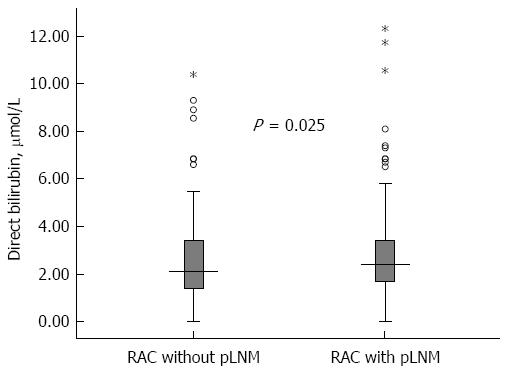Copyright
©The Author(s) 2016.
World J Gastroenterol. Feb 28, 2016; 22(8): 2576-2584
Published online Feb 28, 2016. doi: 10.3748/wjg.v22.i8.2576
Published online Feb 28, 2016. doi: 10.3748/wjg.v22.i8.2576
Figure 1 Baseline serum direct bilirubin concentration (median and inter-quartile range) in rectal adenocarcinoma patients with and without lymph node metastasis.
Error bars indicate full ranges and the five-pointed stars indicate the exceptional values.
Figure 2 Association between concentrations of increased serum direct bilirubin and lymph node metastasis.
Patients were separated into four groups based on the concentration of direct bilirubin (DBil), including DBil ≤ 1.50 μmol/L, 1.50 μmol/L < DBil ≤ 2.50 μmol/L, 2.50 μmol/L < DBil ≤ 3.50 μmol/L, and DBil > 3.50 μmol/L. The histograms indicate the percentages of patients with lymph node metastasis (LNM) in each group.
Figure 3 Survival analysis: Kaplan-Meier curve (log rank test) showed that serum direct bilirubin was associated with the prognosis (survival time) in rectal adenocarcinoma patients.
The cutoff (direct bilirubin ≥ 2.60 μmol/L) was determined based on the combination of sensitivity, specificity, ROC curve and areas under the curve.
- Citation: Gao C, Fang L, Li JT, Zhao HC. Significance and prognostic value of increased serum direct bilirubin level for lymph node metastasis in Chinese rectal cancer patients. World J Gastroenterol 2016; 22(8): 2576-2584
- URL: https://www.wjgnet.com/1007-9327/full/v22/i8/2576.htm
- DOI: https://dx.doi.org/10.3748/wjg.v22.i8.2576











